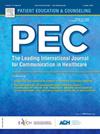系统回顾观察编码系统,以评估患者与医疗保健专业人员的互动
IF 2.9
2区 医学
Q2 PUBLIC, ENVIRONMENTAL & OCCUPATIONAL HEALTH
引用次数: 0
摘要
目的系统编码从独立观察者的角度研究患者与医护人员之间的相互作用。有许多可用的编码系统,但缺乏最新的概述。我们的目标是:(1)提供一个全面的系统概述的系统编码的病人-医疗保健专业人员的互动;并描述它们的一般特征和发展,以及3)验证和适应。方法我们系统地检索了5个数据库(Cochrane、Embase、PubMed/Medline、CINAHL、PsychINFO)中同行评审的实证文章,使用以下关键词的变体:(i)患者和/或其他利益相关者,(ii)医疗保健专业人员,(iii)医疗保健中的相互作用,(iv)编码工具,(v)开发和/或验证。所有标题/摘要和全文均独立筛选,一式两份。此外,编码系统是通过早期的审查、开放获取的研究数据库和到那时为止所有包含的编码系统的前向参考搜索来确定的。对于所有符合条件的系统,我们提取了特征和心理测量特性。结果从文献数据库中共筛选到6950篇文献,筛选出188篇全文文章。35篇文章来自其他来源。我们总共收录了124篇文章,描述了98种编码系统。系统在主题(例如,以患者为中心的沟通,共同决策,行为改变咨询),临床背景(例如,肿瘤学,儿科,通用),开发和报告的严密性,编码复杂性和心理测量测试的程度方面具有高度可变性。大多数编码系统报告了内部信度;只有少数人进行了其他类型的信度或效度测试。结论编码系统过多,但迫切需要更系统的报告和心理测试,以提高证据的效度。测试最初可能集中在最相关和广泛适用的编码系统上。实践意义这些结果可以帮助研究人员选择最合适的编码系统为他们的目的。在开发新的编码系统之前,研究人员可能会考虑使用或调整现有的系统。本文章由计算机程序翻译,如有差异,请以英文原文为准。
Systematic review of observational coding systems to assess patient-healthcare professional interactions
Objectives
Systematic coding is used to study interactions between patients and healthcare professionals from an independent observer perspective. Many coding systems are available, but an up-to-date overview is lacking. We aimed to: (1) provide a comprehensive overview of systems for systematic coding of patient-healthcare professional interactions; and describe their 2) general characteristics and development, and 3) validation and adaptation.
Methods
We systematically searched peer-reviewed empirical articles in five databases (Cochrane, Embase, PubMed/Medline, CINAHL, PsychINFO) using variations of the following keywords: (i) patient and/or other stakeholder, (ii) healthcare professional (iii), interactions in healthcare, (iv) coding tool, and (v) development and/or validation. All titles/abstracts and full-texts were screened independently and in duplicate. Additionally, coding systems were identified through an earlier review, an open-access research database, and a forward-reference search of all included coding systems up to that point. For all eligible systems, we extracted characteristics and psychometric properties.
Results
From a total of 6950 identified articles from literature databases, 188 full-text articles were screened. Thirty-five articles were included from additional sources. In total, we included 124 articles describing 98 coding systems. Systems were highly variable in terms of topic (e.g., patient-centered communication, shared decision making, behavior change counseling), clinical context (e.g., oncology, pediatrics, generic), rigor of development and reporting, coding complexity, and extent of psychometric testing. Inter-rater reliability was reported for most coding systems; only few were tested for other types of reliability or for validity.
Conclusions
A plethora of coding systems are available, but more systematic reporting and psychometric testing are urgently needed to enhance evidence of validity. Testing may initially focus on the most relevant and broadly applicable coding systems.
Practice implications
These results can aid researchers in selecting the most suitable coding system for their purposes. Researchers may consider using or adapting existing systems, before developing new coding systems.
求助全文
通过发布文献求助,成功后即可免费获取论文全文。
去求助
来源期刊

Patient Education and Counseling
医学-公共卫生、环境卫生与职业卫生
CiteScore
5.60
自引率
11.40%
发文量
384
审稿时长
46 days
期刊介绍:
Patient Education and Counseling is an interdisciplinary, international journal for patient education and health promotion researchers, managers and clinicians. The journal seeks to explore and elucidate the educational, counseling and communication models in health care. Its aim is to provide a forum for fundamental as well as applied research, and to promote the study of organizational issues involved with the delivery of patient education, counseling, health promotion services and training models in improving communication between providers and patients.
 求助内容:
求助内容: 应助结果提醒方式:
应助结果提醒方式:


